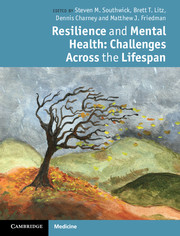Book contents
- Frontmatter
- Contents
- Contributors
- Preface
- Section 1 Pathways to resilience
- Section 2 Resilience across the lifespan
- Section 3 Resilience in families, communities, and societies
- Section 4 Specific challenges
- 13 Loss and grief: the role of individual differences
- 14 Reorienting resilience: adapting resilience for post-disaster research
- 15 Rape and other sexual assault
- 16 The stress continuum model: a military organizational approach to resilience and recovery
- 17 Resilience in the face of terrorism: linking resource investment with engagement
- 18 Resilience in the context of poverty
- 19 Resiliency in individuals with serious mental illness
- Section 5 Training for resilience
- Index
- References
18 - Resilience in the context of poverty
from Section 4 - Specific challenges
Published online by Cambridge University Press: 07 September 2011
- Frontmatter
- Contents
- Contributors
- Preface
- Section 1 Pathways to resilience
- Section 2 Resilience across the lifespan
- Section 3 Resilience in families, communities, and societies
- Section 4 Specific challenges
- 13 Loss and grief: the role of individual differences
- 14 Reorienting resilience: adapting resilience for post-disaster research
- 15 Rape and other sexual assault
- 16 The stress continuum model: a military organizational approach to resilience and recovery
- 17 Resilience in the face of terrorism: linking resource investment with engagement
- 18 Resilience in the context of poverty
- 19 Resiliency in individuals with serious mental illness
- Section 5 Training for resilience
- Index
- References
Summary
Introduction
Resilience has been defined as the manifestation of positive outcomes in the face of some form of adversity (Luthar et al., 2000; Masten, 2001), poverty being one such adversity. Poverty, “the state or condition of having little or no money, goods, or means of support,” has meaning in both relative and absolute terms. Those who are defined as poor in an affluent country like the USA may not seem impoverished, on a more absolute basis, compared with those living in extreme poverty in regions such as sub-Saharan Africa. Nonetheless, individuals who are poor in a more relative sense may still experience significant distress through the comparative wealth they see around them.
Poverty in developed countries indexes a range of social ills that extend beyond the absolute or relative lack of money and goods. Crowded living conditions, community and family violence, drug trafficking, high crime rates, a weaker civil infrastructure, and higher prevalence rates of mental and substance use disorders are issues that are more commonly found in poor communities. These social conditions are better able to fester in impoverished settings and can feed on themselves, creating a downward spiral or “vicious circle,” wherein one problem provokes the emergence or worsening of another. For example, a high crime rate in a neighborhood may lead to businesses deciding to avoid it as a place of investment, leading to higher unemployment and further crime in that area.
- Type
- Chapter
- Information
- Resilience and Mental HealthChallenges Across the Lifespan, pp. 264 - 275Publisher: Cambridge University PressPrint publication year: 2011
References
- 6
- Cited by



